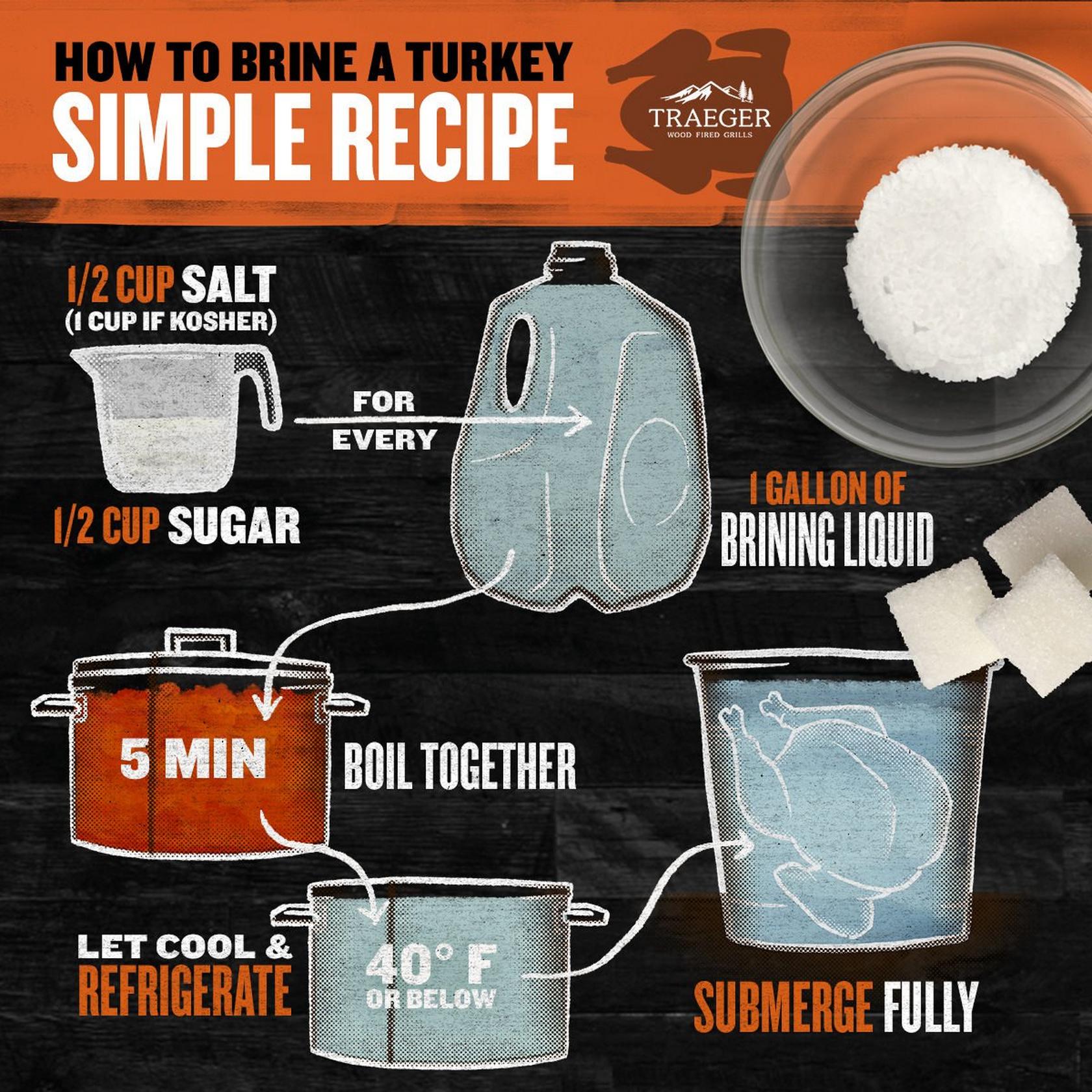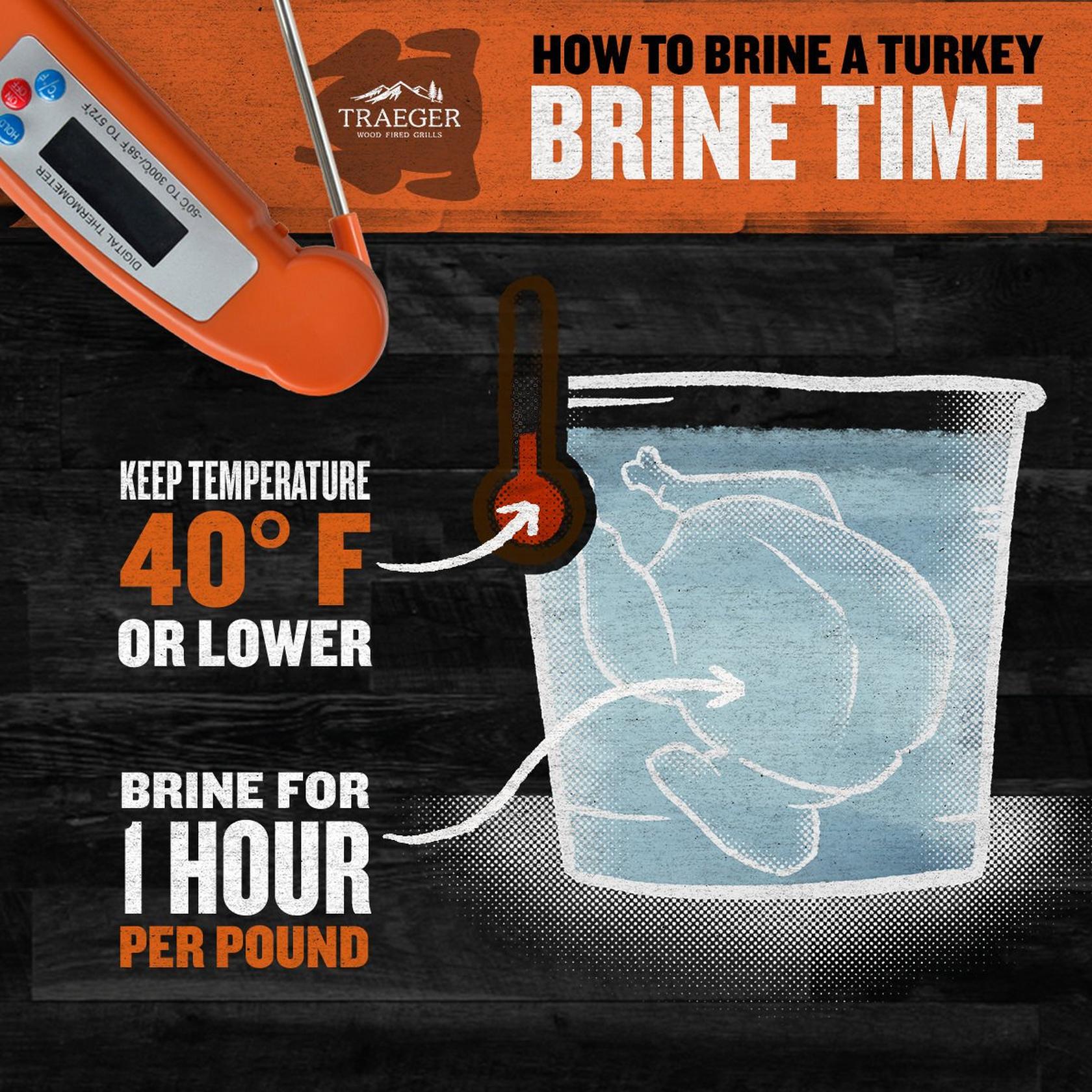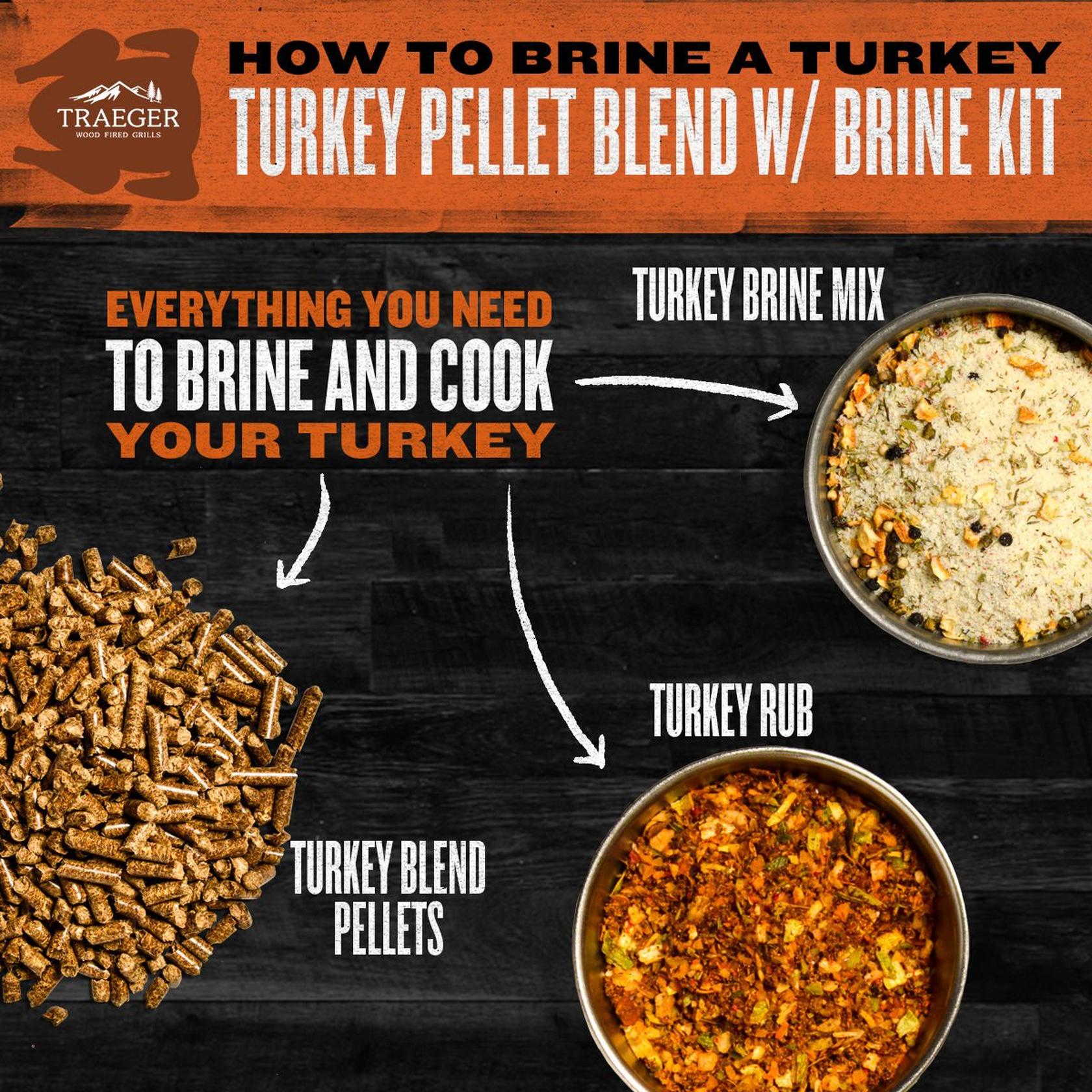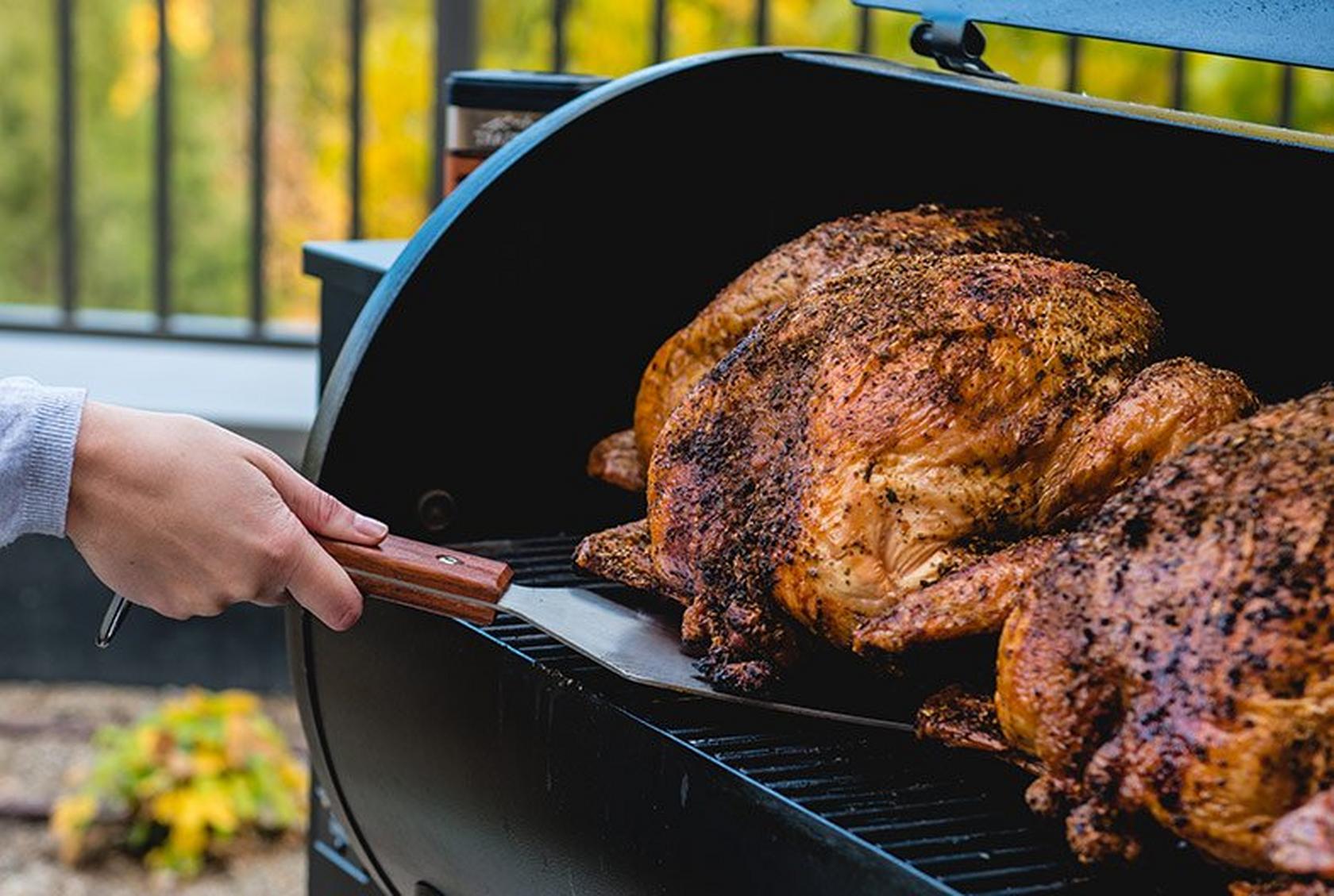
Brining a turkey is the secret to nailing Thanksgiving dinner. Whether you're smoking it low and slow or roasting it to crispy, golden perfection, a good turkey brine locks in moisture while adding flavor to every bite of the meat. If you’ve ever wondered how to brine a turkey, it’s simpler than you think but delivers big results. This one step sets your bird up for maximum flavor, no matter which cooking method you choose. Read this expert guide before Turkey Day to learn all the secrets to epically smoked turkey.
Why Brine a Turkey
Soaking your turkey in a salty bath makes it moist, tender, and full of flavor. The secret to perfect poultry lies not just in how it’s cooked, but in what’s done to it before cooking. This year, carve out some time to brine a turkey.
There are two types of brining you can do to your bird: a wet brine and a dry brine.
A wet brine is a salt and water solution that can also contain sugar and other flavorings. Submerging the turkey in this salty solution for at least a day ensures it will cook up tender and juicy.
How does this work? The salt solution will travel into the turkey, bringing additional moisture (and with it, additional flavor) deep into the meat. When the turkey cooks, it will still lose moisture but now has ample excess, so it stays juicy. The salt also breaks down proteins, making the turkey exceptionally tender, too. Our Traeger Turkey Brine kit is a great place to start. You can see the tasty effects of this on this epic smoked turkey recipe.
A dry brine is similar, minus the water. It locks in your turkey's moisture and enhances its flavor by pulling moisture from the turkey and then dissolving into the meat, creating a natural brine that's reabsorbed. Dry brining also helps produce crispier skin, especially if you let it rest uncovered in the fridge. To dry brine, rub your turkey with a good amount of salt, plus any herbs or spices you want about 24 to 48 hours before cooking.
One thing to keep in mind is that while the smoked turkey won’t taste overly salty, its juices will be quite salty, so if you plan to use them in your gravy, keep that in mind.
Smoked Turkey Brine
Technically, a brine is defined as water saturated with salt. Like we said above, a dry brine is also a great option for turkey, but for this article, we will be focusing on a liquid brine. At its most basic, a brine for pellet grill turkey is a mix of water and salt, but you can infuse extra flavor by adding other ingredients, such as sugar, garlic, herbs, and other liquids.
How to Brine a Turkey
When creating a brine—whether for Traeger turkey, chicken, or a rack of ribs—there are a few key steps.
Before you even start, however, be sure you have procured a turkey that has not already been treated. For example, a kosher turkey has already been salted so brining it would result in it being too salty. You can also find pre-brined turkeys at the market, which have been injected with a brine. To determine if the turkey has been brined or salted, check the label and make sure there are no additional ingredients.
Here are some general tips for brining before we dive into wet brining vs dry brining:
-
For the best results, you will want to start the process a couple of days before you plan to cook your turkey (you can refer to our guide on how long to cook a turkey).
-
Brine time depends on the size of your bird — plan for about 12 hours minimum, though 24 hours gives better flavor and juiciness.
-
After brining, remove the turkey and let it air dry for the crispiest skin. Aim for at least 12 hours of drying time, but 24 is ideal.
-
A general rule of thumb: 1 hour of brining per pound of turkey, with 24 hours as the maximum.
-
Keep the brine below 40°F throughout the entire process to prevent bacteria growth. Make room in your fridge ahead of time to ensure the turkey stays safely chilled.
-
A successful brine starts with salt. Use about 1 cup of salt per gallon of water (½ cup minimum).
-
Crystal size matters:
-
Table salt = finer grains → more concentrated brine.
-
Kosher or sea salt = larger crystals → slightly less salty brine.
-
-
Most brines also include sugar (white or brown). Sugar doesn’t change texture but helps with flavor and browning.
-
Boost flavor by adding other liquids like apple cider, stock, beer, or wine — just use them to complement, not replace, the water. Avoid too much salt-heavy or acidic liquid (like vinegar or soy sauce), which can throw off the balance.
-
Add aromatics to enhance flavor: garlic, onion, fresh herbs, apple slices, or citrus peel work beautifully.
How to Wet Brine a Turkey
Step 1: Find the Right Container
You’ll need a large pot or brining container that can hold your turkey fully submerged in the brine. If you don’t have space in the fridge, double-bag two unscented garbage bags and place the turkey inside. Pour in the cold brine until the turkey is fully covered, seal each bag tightly, and place it in a large cooler. Surround the bagged turkey with bags of ice to keep it below 40°F. Check periodically and add more ice as needed.
Step 2: Bring the Brine to a Boil, Then Let It Cool Completely
To let the ingredients fully combine and dissolve the salt and sugar, bring your brine to a boil. Just as important is cooling it completely before adding the turkey. If the brine is warm when you submerge the bird, it can raise the turkey into the bacterial danger zone. To cool your brine more quickly, dissolve the salt and sugar in a smaller amount of hot water, then add cold water to bring the temperature down.
Step 3: Submerge and Brine the Turkey
Once the brine has cooled, add your turkey and keep it in the fridge for at least 12 hours and up to 24 hours. The general rule of thumb is one hour per pound of turkey. If you’re not sure what size of turkey to buy, check out our turkey size guide.
Step 4: Remove and Air Dry
After brining, remove the turkey and pat it dry with paper towels. Place it on a rack set over a baking sheet and refrigerate uncovered for 12 to 24 hours to let the skin dry out. Once dry, your turkey is ready for seasoning, rubbing, or going straight on the Traeger.
(For an easy brine that’s also delicious, consider the Traeger Orange Brine and Turkey Rub Kit.)
Try this Maple and Bourbon Brine Turkey Recipe to see if a wet brine is for you.


How to Dry Brine a Turkey

Step 1: Plan Ahead
A dry brine takes a little time but very little effort. You’ll want to start at least one day before cooking, though two to three days is even better. The salt needs time to draw out the turkey’s natural juices, dissolve into them, and then pull that flavorful liquid back into the meat. This process keeps the turkey juicy and seasons it throughout.
Step 2: Prepare the Turkey
Start with a thawed turkey and remove any giblets or packaging inside the cavity. Pat the entire bird dry with paper towels. A dry surface helps the salt stick evenly.
Step 3: Mix and Apply the Dry Brine
Combine kosher salt with any additional seasonings you like. A good rule of thumb is about one tablespoon of kosher salt per five pounds of turkey. You can mix in brown sugar, black pepper, herbs, or citrus zest if you want more flavor.
Gently loosen the skin over the breast and thighs so you can apply some of the salt directly to the meat. Rub the salt mixture all over the turkey, inside and out, and under the skin where possible.
Step 4: Let It Rest in the Fridge
Place the seasoned turkey on a wire rack set over a baking sheet to catch any drips. Refrigerate it uncovered for at least 24 hours, or up to 72 hours if you have the time. Leaving it uncovered helps the skin dry out, which gives you crispier, more golden-brown skin once it’s roasted or smoked.
If you’re worried about fridge space or the smell of raw turkey, you can loosely tent it with foil for part of the time, then uncover it for the final 12 hours to help the skin dry completely.
Step 5: Cook Without Rinsing
Once you’re ready to cook, don’t rinse off the brine. Simply pat the turkey dry again if needed and apply a light coating of oil or butter before seasoning with any additional rubs. The salt from the dry brine has already absorbed into the meat and will keep it juicy as it cooks.
Turkey Brining Tips

- Don’t add extra salt when seasoning after brining. The turkey has already absorbed salt during the process, so additional salt can make it overly salty.
- Skip pre-basted or self-basting turkeys. These already contain a salt solution, and brining them again can lead to mushy, overly seasoned meat.
- Brining helps lock in moisture and gives you a juicier bird. It also allows smoke flavor to penetrate the meat more evenly without turning it salty.
- Always keep your turkey and brine below 40°F to prevent bacterial growth. Make sure your fridge or cooler can maintain a safe temperature throughout the process.
- If you’re short on time, even a few hours of brining will make a noticeable difference in flavor and tenderness.
- Whether wet or dry, let the turkey air dry uncovered in the fridge before cooking. This step helps the skin crisp beautifully once it hits the heat.
- Use kosher salt whenever possible. Its larger grains are easier to distribute evenly and dissolve more consistently in brine.
- For extra flavor, add aromatics like herbs, citrus, or garlic to your brine or rub. Just remember that subtlety goes a long way. The goal is to enhance, not overpower, the natural flavor of the turkey.
- Make sure your brine is completely cooled before adding the turkey. Warm brine can bring the raw bird into the bacterial danger zone.
- If you’re dry-brining, don’t rinse the turkey before cooking. Simply pat it dry, add a light coating of oil or butter, and season as desired.
FAQ's
What is turkey brining?
Turkey brining is the process of soaking a turkey in a solution of salt, water, and often other flavor-enhancing ingredients like herbs, spices, and sweeteners. This helps to season the turkey, make it more flavorful, and keep it moist during cooking. Especially when you're making smoked turkey.
How long to brine a turkey for smoking?
The length of time that you brine a turkey depends on the size and specific recipe. However, here is a good rule of thumb:
- Small to medium sized turkey (12-14 pounds): Brine for around 12-18 hours.
- Large Turkey (15-20 pounds): Brine for about 18-24 hours.
Why should I brine my turkey?
Brining a turkey has several benefits. It adds flavor to the meat, making it more tasty and savory. It also helps to retain moisture, preventing the turkey from becoming dry during roasting. Brining can result in a more tender and succulent Traeger smoked turkey.
Can you brine and smoke a Turkey?
Absolutely. Smoking can sometimes dry out meat if you're not careful. Since brining infuses the turkey with moisture and salt, it keeps it juicy throughout the long process. It also enhances the flavor and tenderizes the pellet grill turkey.
How to smoke a turkey
Smoking a turkey on a pellet grill is straightforward and perfect for the holidays. You'll start by setting your grill to 225°F for that perfect low-and-slow cook. After prepping your turkey, you will smoke your bird until the internal temperature reaches 165°F, usually taking about 30 minutes per pound. You can monitor that best through an internal meat thermometer MEATER.
How to roast a turkey on the Traeger
To roast a turkey on the Traeger, preheat the grill to 325°F for a steady, even cook. Place the seasoned turkey directly on the grill grates or in a roasting pan, and close the lid to let the wood-fired heat do its job. Roast the turkey until the internal temperature hits 165°F, which typically takes around 15 minutes per pound.
Can you brine a frozen turkey?
Can you brine a frozen turkey? When you go shopping for your turkey, you'll most likely find it frozen and luckily for you, you can brine it. To brine a frozen turkey, start by thawing it in the refrigerator for at least 24-48 hours, or until it’s partially defrosted. Once it’s thawed enough to handle, submerge the turkey in your solution and brine in the fridge for 24-48 hours, allowing it to fully thaw while absorbing moisture and flavor before cooking.
Can you brine a spatchcock turkey?
Yes! It's easy to spatchcock turkey (especially when you check out our guide). If you're curious about the best brined spatchcock turkey recipes, take a look at our Traeger spatchcock turkey recipe.
Best Wood Chips for Smoking a Brined Turkey
Go for mild, balanced hardwoods that won’t overpower the flavor of the brine. Apple and cherry add a touch of sweetness, and pecan brings a deeper, nutty flavor that pairs perfectly with poultry. If you want a little more punch, mix in a bit of hickory for a classic smoked turkey profile.
You can also check out our article to figure out the best pellets for turkey.
How Long to Smoke a Brined Turkey by Weight
Smoke your turkey at 325°F and plan for about 15 minutes per pound. Every bird is different, so use internal temperature as your guide. A smaller turkey around 12 pounds usually takes about 3 to 3½ hours, while a 20-pound bird can run closer to 5 hours. Always trust your thermometer over the clock.
Temperature and Probe Placement for a Juicy Smoked Turkey
Insert your probe into the thickest part of the breast, avoiding any bones. This gives you the most accurate read on doneness. You’re looking for 165°F in the breast and 175°F in the thigh for perfect results. If you’re using MEATER, the app will track both internal and ambient temps for you, so you can relax and let the tech do the work.
Quick Dry Brine Alternative Before Smoking
If you’re short on time, mix a generous handful of kosher salt with your favorite rub or a little brown sugar and rub it directly onto the turkey. Let it rest uncovered in the fridge for at least 4 to 6 hours. Even a quick dry brine gives the salt time to pull moisture, dissolve, and reabsorb, locking in flavor and helping the skin crisp up beautifully on the Traeger.
How to Season the Turkey After Brining
Skip the extra salt. After brining, the bird is already seasoned inside and out. Pat it dry, brush it with oil or melted butter, and then apply your favorite salt-free rub or a Traeger blend made for poultry. This gives you the perfect balance of flavor and color without pushing it into salty territory.
Brined Turkey Recipes
Now that you know all the essentials for brining your bird, take a look at our favorite brined turkey recipes:
Smoked Orange & Bourbon Brined Turkey
by Traeger Kitchen
5 Reviews
Prep Time
20 Min
Cook Time
4 Hr
Serves
8
Pellets
Apple
Take your turkey hunt by the tail feathers and turn that gobbler into a warm citrus and bourbon-infused feast. This smoked bourbon brined turkey with the Trager orange brine and turkey rub kit is great for holidays or any freshly-fetched trophy.
Ingredients
main
| 1 | Traeger Orange Brine and Turkey Rub Kit |
| 4 Quart | cold water, divided, plus more as needed |
| 1 Cup | bourbon |
| 1 | (12-14 lb) turkey, thawed if frozen |
| 1 Tablespoon | unsalted butter, melted |
| 1 Tablespoon | orange-flavored liquor, such as Grand Marnier |
1
In a large pot, combine the Orange Brine Seasoning (from the Traeger Orange Brine & Turkey Rub Kit) with 1 quart of water. Bring to a boil over high heat and cook for 5 minutes. Remove the pot from the heat and add the remaining 3 quarts of water and the bourbon. Refrigerate until completely chilled.
2
Place the turkey, breast-side down, in a large container. Pour the cooled brine over the bird, adding more cold water if needed to fully cover. Place a few plates on top to weigh the turkey down and completely submerge in the brine. Refrigerate for 24 hours.
3
Remove the bourbon brined turkey from the brine and pat dry with paper towels. Discard the brine.
4
In a small bowl, mix together the melted butter and orange-flavored liqueur, then evenly rub all over the outside of the turkey. Season the outside of the turkey with the Traeger Turkey Rub (from the Orange Brine & Turkey Rub Kit).
5
When ready to cook, set the Traeger temperature to 225˚F and preheat with the lid closed for 15 minutes. For optimal flavor, use Super Smoke, if available.
6
Insert the probe into the thickest part of a turkey thigh. Place the turkey directly on the grill grates, breast-side up. Close the lid and smoke for 2 hours.
7
Increase the Traeger temperature to 350˚F and roast the turkey until the internal temperature reaches 165°F, 2-3 hours more, depending on the size of the turkey.
8
Remove the turkey from the grill and let rest for 20-30 minutes before carving. Enjoy!